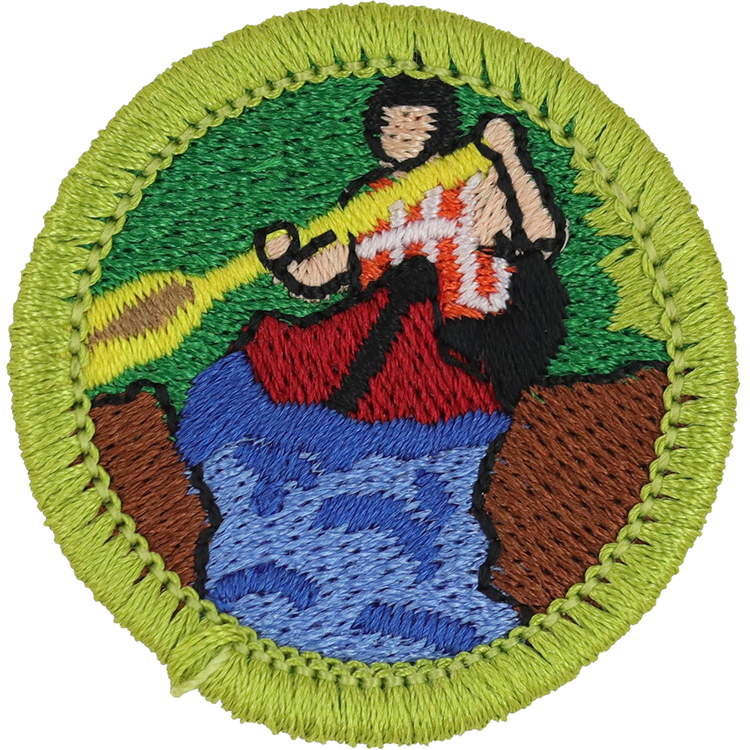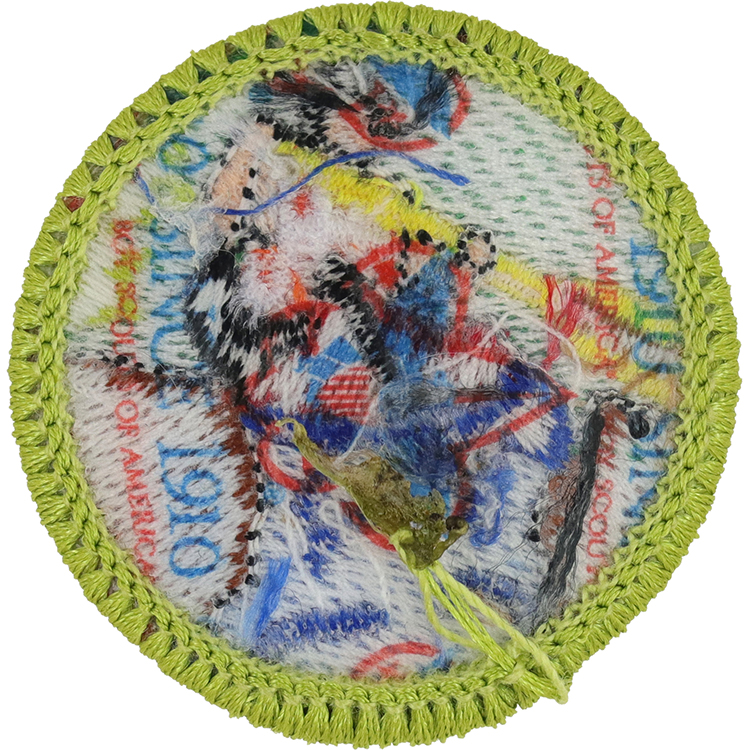
Fig. 1: WhiWat-L1-Front
- Embroidery: Rayon thread
- Border: Merrowed

Fig. 2: WhiWat-L1-Reverse
- Back: Since 1910 imprint with large Tenderfoot image
Item Name: White Water 2014 - Current
Item ID: WhiWat-L1
Collector Rating: 1
Requirements January 1998 until January 2015
1. Show that you know first aid for injuries or illnesses that could occur while working on the Whitewater merit badge, including hypothermia, heatstroke, heat exhaustion, dehydration, sunburn, insect stings, tick bites, blisters, and hyperventilation.
2. Do the following:
(a) Identify the conditions that must exist before performing CPR on a person. Explain how such conditions are recognized.
(b) Demonstrate proper technique for performing CPR using a training device approved by your counselor.
3. Before doing the other requirements earn the Canoeing merit badge, then do the following:
(a) Demonstrate basic canoe-handling skills by completing the English Gate Test within 120 seconds while paddling tandem with a buddy.
(b) Review and compare BSA Safety Afloat and the American Whitewater Association Safety Code and demonstrate your understanding of these principles by answering questions from your counselor.
4. Identify and explain the use of safety equipment on running water.
5. Explain the International Scale of River Difficulty and apply the scale to the stretch of river where you are practicing and demonstrating your whitewater skills. Identify the specific characteristics of the river that are factors in your classification according to the International Scale.
5. Explain how to scout and read a river both while afloat and from ashore. Explain open and closed V's, shoals with broken or dancing water, boils, strainers, broken drops, haystacks, dams, falls and lowhead obstructions, eddies, whirlpools, crosscurrents, flat rocks, standing waves, sheer drops, and heavy water. Demonstrate your ability to read the river where you are practicing and demonstrating your whitewater skills.
6. Explain the differences between flatwater and whitewater canoes; identify the advantages and special uses for kayaks and decked canoes in running water. Identify the different materials used in modern whitewater canoe construction and the advantages and disadvantages of each.
7. Identify paddles designed for whitewater use and explain their special characteristics.
8. Do ONE of the following:
(a) Demonstrate paddle strokes in the bow position of an open canoe on running water, for forward movement, sideways movement, and backward movement. Repeat in the stern position.
(b) Demonstrate forward, backward, and sideways movement on running water using a single- or double-bladed paddle in a kayak or decked canoe.
10. While paddling alone or with a partner in an open canoe, or while alone in a kayak, demonstrate forward and back eddy, eddy turn, peeling out of an eddy, and high and low braces.
11. xplain and demonstrate:
(a) Self-rescue and procedures when capsized in running water
(b) Safe rescue of others in various whitewater situations
(c) Portaging_-when and how to do it
(d) The whitewater buddy system using at least three persons and three craft
11. Discuss the use of inflatable boats on moving water. Explain how to safely outfit and use an inflatable boat in whitewater including the type of craft suited to certain water conditions, how to maneuver the craft on the water, and what special safety precautions should be taken when using an inflatable boat.
12. Explain the risks of "tubing" on moving water.
13. Participate in a 1-day whitewater trip for beginners. Help to prepare a written plan specifying route, schedule, equipment, safety precautions, and emergency procedures. Determine local rules and obtain permission from local property owners. Explain what steps you have taken to comply with BSA Safety Afloat and the American Whitewater Association Safety Code. Execute the plan with others.
Requirements January 2015 until Current
1. Do the following:
- Explain to your counselor the most likely hazards you may encounter while participating in whitewater activities and what you should do to anticipate, help prevent, mitigate, and respond to these hazards.
- Review with your counselor the prevention, symptoms, and first aid treatment for the following injuries or illnesses that could occur while participating in whitewater activities including cold-water shock; hypothermia; head, neck, and back injuries; heat-related illnesses; sunburn; dehydration; blisters; bruises; cuts; sprains and strains; shoulder dislocation; and submersion injuries.
- Discuss with your counselor the BSA Safety Afloat policy and the American Whitewater safety guidelines.
2. Do the following:
- Explain the following river features; upstream V. downstream V. riffle, eddy, eddy line, pillow, ledge, bend, shallows, current, drop, horizon line, wave, standing wave, wave train.
- Explain when, why, and how you should scout a river while ashore and while on the river.
3. Before doing requirements 4 through 12, earn the Canoeing merit badge if you will be using a canoe to earn this merit badge. If you will be using a kayak, earn the Kayaking merit badge. Then do the following:
- If you will be using a canoe to earn this merit badge, demonstrate strokes and maneuvers from Canoeing merit badge to the satisfaction of your merit badge counselor.
OR
- If you will be using a kayak to earn this merit badge, demonstrate strokes and maneuvers from the Kayaking merit badge to the satisfaction of your merit badge counselor.
4. Do ONE of the following:
- If you are completing these requirements as a tandem canoeist, perform the following on calm water:
- Demonstrate the following strokes in the bow: cross forward, bow draw, cross bow draw, bow pry, Duffek, sculling draw, and sculling pushaway (reverse scull).
- Demonstrate the following strokes in the stern: stern draw, stern pry, sculling draw, sculling pushaway (reverse scull), and forward with stern pry.
- Demonstrate a high brace, low brace, and a righting pry.
OR
- If you are completing these requirements as a solo canoeist, perform the following on calm water:
- Demonstrate the following strokes: cross forward, bow draw, cross bow draw, stern draw, pry, stern pry, Duffek, sculling draw, sculling pushaway (reverse scull), and forward with stern pry.
- Demonstrate a high brace, low brace, and righting pry.
OR
- If you are completing these requirements as a solo kayaker, perform the following on calm water:
- Demonstrate the following strokes: Duffek, bow draw, perform the sculling draw.
- Demonstrate a high brace and low brace.
5. Do the following:
- Explain the International Scale of River Difficulty and apply the scale to the stretch of river approved by your counselor.
- Identify the specific characteristics of the river that are factors in your classification according to the International Scale.
- Discuss how the level of flow changes a river from one class to another and what effects different flow rates have on the features of a river and its hazards.
6. Explain the importance of communication during every whitewater outing. Demonstrate knowledge and ability to use the following American Whitewater Universal River Signals, both visual and auditory: “Stop,” “Are you OK?,” “Help/emergency,” “Run river right,” “Run river left,” and “All clear – come ahead.”
7. Do ONE of the following:
- If completing this merit badge in a canoe, describe the various types of canoes used on moving water and how they differ in design, materials, or purpose.
OR
- If completing this merit badge in a kayak, describe the various types of kayaks used on moving water and explain how they differ in design, materials, and purpose.
8. Discuss the personal and group equipment necessary for a safe whitewater outing and how and why it is used. Explain how to pack and protect these items.
9. Do the following:
- Demonstrate your ability to read a Class II section of river approved by your counselor. Describe the most desirable paths or lines of travel as well as alternative routes and options. Point out how to use the existing water features to your advantage, and explain how to best avoid the hazards present.
- Wearing a proper life jacket and being appropriately dressed for the weather and water conditions, perform the following skills in moving water in a properly equipped whitewater craft of your choice (tandem canoe, solo canoe, or solo kayak). If a tandem canoe is used, the skills must be demonstrated from both the bow and stern positions.
- Launch and land
- Paddle forward in a straight line
- Backpaddle
- Ferry upstream.
- Ferry downstream.
- Eddy turn.
- Peel out.
10. Explain and demonstrate the following to your counselor:
- Self-rescue and procedures when capsized in moving water, including a wet exit if necessary.
- Proper use of a throw rope to rescue a swimmer in whitewater
- Proper technique for receiving a throw rope as a swimmer
- Portaging – where portaging would be appropriate, and when and how to do it.
- The whitewater buddy system using at least three persons and three craft.
11. Discuss the use of inflatable rafts on moving water. In your discussion, explain the special safety precautions that should be taken when using an inflatable raft and the risks of “tubing” on moving water.
12. Participate in a whitewater trip using either a canoe or kayak on a Class I or Class II river. Help to prepare a written plan, specifying the route, schedule, equipment, safety precautions, and emergency procedures. Determine local rules and obtain permission from landowners and land managers in advance. Explain what steps you have taken to comply with BSA Safety Afloat and the American Whitewater safety guidelines. Execute the plan with others.
